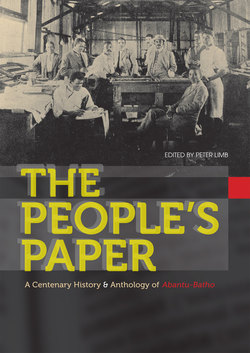Читать книгу The People’s Paper - Christopher Lowe - Страница 13
На сайте Литреса книга снята с продажи.
THE POLITICAL CONTEXT
ОглавлениеAbantu-Batho emerged at a time of intense black protest focused on the racist clauses of the Act of Union and the 1913 Natives’ Land Act. The black press united in its criticism of the exclusion of blacks from the franchise121 and such determined opposition would have imprinted itself on the minds of Abantu-Batho writers. Chapter 1 in this volume analyses in detail the political content and context of the paper, but it is useful here to sketch this.
The political tone was moderate-to-radical; ‘centre-left’ in today’s parlance. We cannot say that a systematic political doctrine was articulated; there was an eclectic philosophic mix, with editors appropriating ideas from Garvey, Mill, Marx and, in Grendon’s case, Swedenborg. In 1931 editors claimed a consistency in its philosophy over the years (see the Conclusion), and while we can see big differences between, say, the moderate or radical politics of Skota and Letanka, the common threads of African nationalism, Pan-Africanism and anti-racism did indeed bring some coherence.
The question of political affiliation/control is complex, and discussed in chapter 1. While there is nothing about a press organ in the 1919 SANNC constitution or its draft predecessor, and while in 1913 there was reference to six different ‘Newspaper Press Organs’ of the SANNC, Article 19 of the TNC constitution of 1919 specifies that ‘[t]he official organ of the Congress shall be the “ABANTU-BATHO”’.122 In the late 1920s J. T. Gumede declared it the ANC’s organ, but withdrew this naming from the masthead in 1930 when defeated by Seme who, now in control of Congress, had his own paper and ironically distanced himself from the one he had founded.
Did Abantu-Batho’s adoption as organ of the Transvaal Congress or ANC involve direct control or only mutual support? A company technically owned the paper and there are articles critical of the SANNC and, after Gumede’s 1930 fall from grace, of the ANC, so in this regard it was not entirely a party organ. Its columns were open to different writers. In its early years it boasted moderates Seme, Kunene and Saul Msane, while Skota, editor in the late 1920s, was also of this mould. Whether Congress supported the paper or whether its own fragility was a hindrance to long-term press survival is unclear, but it seems likely that the close association initially provided capital, subscribers and wider public interest, but ANC stagnation then brought reduced resources and, as seen in criticism in the poetry of Nontsizi,123 social distance or ostracism. The relationship with the Transvaal Congress was of a slightly different nature: with both being based in Johannesburg, this relationship was regular and intimate, and there all five languages of the paper were spoken.
I discern several distinct phases. From 1912 to 1917 Abantu-Batho was generally moderate. Yet already in 1916 signs of a growing radicalism were evident, as in the sharp editorialising of Grendon. The 1917 changes in SANNC leadership, with Makgatho defeating Dube and Seme retreating, saw Abantu-Batho back Makgatho, reprinting his 1918 SANNC address in full.124 On the split, Hughes points to the emergence (in the words of Thema) of ‘Msaneites and Dubeites’ as ‘the former used the pages of Abantu-Batho, and the latter Ilanga, to trade insults’.125
The period 1917–20 is the first radical phase. Within this, we can date Msane’s fall from grace in July 1918 when pilloried as ‘Isita sa Bantu’ (enemy of the people), a class enemy in a frock coat and top hat, ‘thick with the whitemen’.126 The strikes of February 1920 mark the high point of this radicalism; afterwards comes stagnation and ostracism. The paucity of 1921–27 issues makes characterisation of its politics difficult, but growing Garveyist influence sits side by side with moderate voices. Finally, a second radical phase, identifying more closely with the Communist Party of South Africa (CPSA), develops from 1927, although this is not uniform across all editors and language columns, a co-existence illustrated in the complex personality of Champion.
In terms of support, Bengt Sundkler’s 1948 comment is still apposite. Congress (and perhaps its organ) grew ‘out of the resentment against the passing of the Natives Land Act’; it ‘reached the peak of its influence about 1918–24; it later lost its grip on the masses’.127 The issue of being an ANC ‘organ’ arises again. After his election as ANC president in 1927 J. T. Gumede made the paper the national organ, but it was in decline by then. Skota’s 1929 report as ANC secretary general states (somewhat elliptically) that ‘[t]he Abantu Batho affair is somewhat complicated, but I am sure the President and other officers will submit a clear report on the Abantu Batho’.128 Gumede took on its financial liability on behalf of the ANC, but Seme deposed him in 1930. The ironic result was a press both pro-and anti-Congress, critical of the new leadership, but gathering around it some ANC stalwarts. The end came in July 1931, and this is discussed in the Conclusion to this volume.
